Blog & Latest Updates
Fly Fishing Articles
Insects by Common Name


Mayfly Species Ephemerella aurivillii
Taxonomic Navigation -?-
Kingdom
Animalia (Animals)
» Phylum
Arthropoda (Arthropods)
» Class
Insecta (Insects)
» Order
Ephemeroptera (Mayflies)
» Species aurivillii
This is page 2 of specimens of Ephemerella aurivillii. Visit the main Ephemerella aurivillii page for:
- The behavior and habitat of Ephemerella aurivillii.
Pictures of 21 Mayfly Specimens in the Species Ephemerella aurivillii:
Ephemerella aurivillii Mayfly Nymph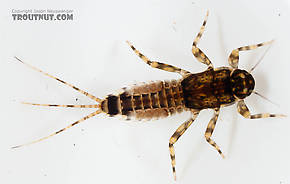 View 7 Pictures
View 7 Pictures
 View 7 Pictures
View 7 PicturesCollected May 10, 2008 from the Chena River in Alaska
Added to Troutnut.com by Troutnut on April 20, 2011
Added to Troutnut.com by Troutnut on April 20, 2011
Ephemerella aurivillii Mayfly Nymph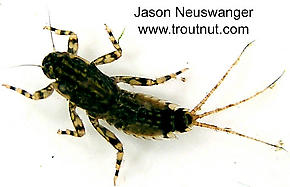 View 5 PicturesClose examination under a microscope showed definite small tubercles (
View 5 PicturesClose examination under a microscope showed definite small tubercles (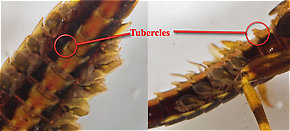 Tubercle: Various peculiar little bumps or projections on an insect. Their character is important for the identification of many kinds of insects, such as the nymphs of Ephemerellidae mayflies.) on the back of this nymph.
Tubercle: Various peculiar little bumps or projections on an insect. Their character is important for the identification of many kinds of insects, such as the nymphs of Ephemerellidae mayflies.) on the back of this nymph.
 View 5 PicturesClose examination under a microscope showed definite small tubercles (
View 5 PicturesClose examination under a microscope showed definite small tubercles (
A few (not all) of the abdominal tubercles on this Ephemerella needhami nymph are circled. They are especially large in this species.
Collected February 5, 2004 from unknown in Wisconsin
Added to Troutnut.com by Troutnut on January 25, 2006
Added to Troutnut.com by Troutnut on January 25, 2006
Ephemerella aurivillii Mayfly Nymph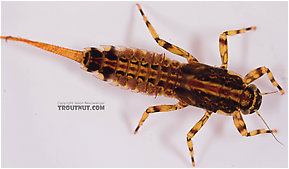 View 6 PicturesThis specimen was collected together with a lighter one of the same species.
View 6 PicturesThis specimen was collected together with a lighter one of the same species.
It resembles another specimen from about 1300 miles away in Wisconsin, which I tentatively called Ephemerella needhami. This one has much less prominent abdominal tubercles ( Tubercle: Various peculiar little bumps or projections on an insect. Their character is important for the identification of many kinds of insects, such as the nymphs of Ephemerellidae mayflies.). It may be that they're both the same species and I don't have my identifications straight.
Tubercle: Various peculiar little bumps or projections on an insect. Their character is important for the identification of many kinds of insects, such as the nymphs of Ephemerellidae mayflies.). It may be that they're both the same species and I don't have my identifications straight.
 View 6 PicturesThis specimen was collected together with a lighter one of the same species.
View 6 PicturesThis specimen was collected together with a lighter one of the same species.It resembles another specimen from about 1300 miles away in Wisconsin, which I tentatively called Ephemerella needhami. This one has much less prominent abdominal tubercles (

A few (not all) of the abdominal tubercles on this Ephemerella needhami nymph are circled. They are especially large in this species.
Collected April 19, 2006 from Mongaup Creek in New York
Added to Troutnut.com by Troutnut on April 21, 2006
Added to Troutnut.com by Troutnut on April 21, 2006
Ephemerella aurivillii Mayfly Nymph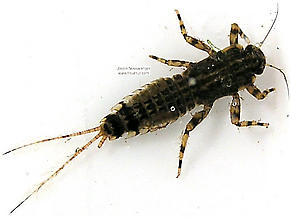 View 4 Pictures
View 4 Pictures
 View 4 Pictures
View 4 PicturesCollected February 5, 2004 from unknown in Wisconsin
Added to Troutnut.com by Troutnut on January 25, 2006
Added to Troutnut.com by Troutnut on January 25, 2006
Ephemerella aurivillii Mayfly Nymph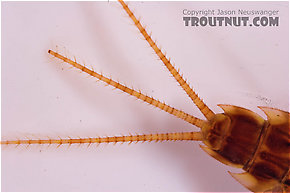 View 4 PicturesThis specimen was collected together with a darker one of the same species.
View 4 PicturesThis specimen was collected together with a darker one of the same species.
 View 4 PicturesThis specimen was collected together with a darker one of the same species.
View 4 PicturesThis specimen was collected together with a darker one of the same species.Collected April 19, 2006 from Mongaup Creek in New York
Added to Troutnut.com by Troutnut on April 21, 2006
Added to Troutnut.com by Troutnut on April 21, 2006
Ephemerella aurivillii Mayfly Nymph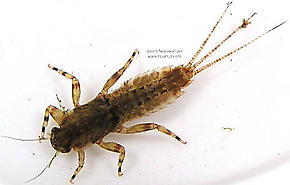 View 3 PicturesThis specimen seems to be morphologically identical to the darker specimens of its species, but it's a very distinctly different color. I'm guessing this is a gender difference, just as I've guessed for the similar E. subvaria nymphs.
View 3 PicturesThis specimen seems to be morphologically identical to the darker specimens of its species, but it's a very distinctly different color. I'm guessing this is a gender difference, just as I've guessed for the similar E. subvaria nymphs.
 View 3 PicturesThis specimen seems to be morphologically identical to the darker specimens of its species, but it's a very distinctly different color. I'm guessing this is a gender difference, just as I've guessed for the similar E. subvaria nymphs.
View 3 PicturesThis specimen seems to be morphologically identical to the darker specimens of its species, but it's a very distinctly different color. I'm guessing this is a gender difference, just as I've guessed for the similar E. subvaria nymphs.Collected February 5, 2004 from unknown in Wisconsin
Added to Troutnut.com by Troutnut on January 25, 2006
Added to Troutnut.com by Troutnut on January 25, 2006
Ephemerella aurivillii Mayfly Nymph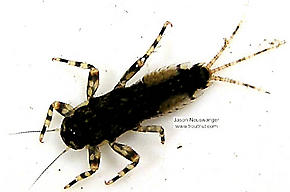 View 3 Pictures
View 3 Pictures
 View 3 Pictures
View 3 PicturesCollected February 5, 2004 from unknown in Wisconsin
Added to Troutnut.com by Troutnut on January 25, 2006
Added to Troutnut.com by Troutnut on January 25, 2006
Ephemerella aurivillii Mayfly Nymph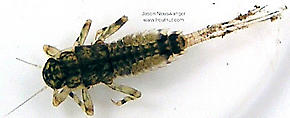 View 3 PicturesExamination of this specimen under a microscope revealed that it does have small abdominal tubercles (
View 3 PicturesExamination of this specimen under a microscope revealed that it does have small abdominal tubercles ( Tubercle: Various peculiar little bumps or projections on an insect. Their character is important for the identification of many kinds of insects, such as the nymphs of Ephemerellidae mayflies.), 2-banded femora (
Tubercle: Various peculiar little bumps or projections on an insect. Their character is important for the identification of many kinds of insects, such as the nymphs of Ephemerellidae mayflies.), 2-banded femora (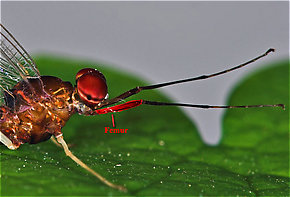 Femur: The main segment of an insect's leg close to the body, in between the tibia and the trochanter.), and banded tails.
Femur: The main segment of an insect's leg close to the body, in between the tibia and the trochanter.), and banded tails.
 View 3 PicturesExamination of this specimen under a microscope revealed that it does have small abdominal tubercles (
View 3 PicturesExamination of this specimen under a microscope revealed that it does have small abdominal tubercles (
A few (not all) of the abdominal tubercles on this Ephemerella needhami nymph are circled. They are especially large in this species.

The femur of this Isonychia bicolor mayfly spinner is highlighted in red.
Collected February 5, 2004 from unknown in Wisconsin
Added to Troutnut.com by Troutnut on January 25, 2006
Added to Troutnut.com by Troutnut on January 25, 2006
Ephemerella aurivillii Mayfly Nymph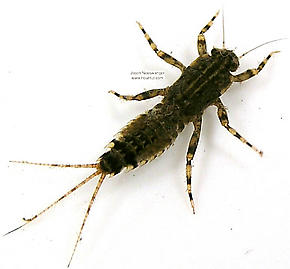 View 3 Pictures
View 3 Pictures
 View 3 Pictures
View 3 PicturesCollected February 5, 2004 from unknown in Wisconsin
Added to Troutnut.com by Troutnut on January 25, 2006
Added to Troutnut.com by Troutnut on January 25, 2006
Ephemerella aurivillii Mayfly Nymph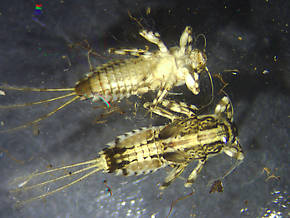 View 3 PicturesI have collected this species in Montana but it is very common in Alaska streams.
View 3 PicturesI have collected this species in Montana but it is very common in Alaska streams.
 View 3 PicturesI have collected this species in Montana but it is very common in Alaska streams.
View 3 PicturesI have collected this species in Montana but it is very common in Alaska streams.Collected June 19, 2010 from the Kwethluk River in Alaska
Added to Troutnut.com by Bnewell on June 26, 2011
Added to Troutnut.com by Bnewell on June 26, 2011
Top 10 Fly Hatches
Top Gift Shop Designs
Eat mayflies.
Top Insect Specimens
Miscellaneous Sites
Troutnut.com is copyright © 2004-2024 Jason
Neuswanger (email Jason). See my FAQ for information about use of my images.
 privacy policy
privacy policy
